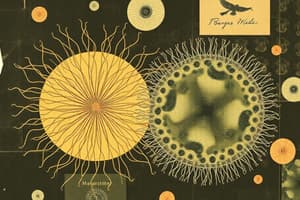Podcast
Questions and Answers
What is the primary function of the cell membrane?
What is the primary function of the cell membrane?
- To produce energy for the cell
- To store genetic information
- To control the movement of substances in and out of the cell (correct)
- To protect the cell's organelles
Which of the following describes the nucleus?
Which of the following describes the nucleus?
- The protective layer surrounding the cell
- A site for protein synthesis
- A large structure that produces energy
- The organelle that contains the cell's genetic material (correct)
What distinguishes unicellular organisms from multicellular organisms?
What distinguishes unicellular organisms from multicellular organisms?
- Unicellular organisms consist of one cell while multicellular organisms are made of many cells (correct)
- Unicellular organisms do not have DNA
- Unicellular organisms lack a cell membrane
- Unicellular organisms have more specialized cells
How many DNA molecules does each human cell typically contain?
How many DNA molecules does each human cell typically contain?
Why are organelles essential to a cell?
Why are organelles essential to a cell?
What is the role of ribosomes in a cell?
What is the role of ribosomes in a cell?
Which of the following correctly describes DNA molecules?
Which of the following correctly describes DNA molecules?
What is formed when cells specialize and work together?
What is formed when cells specialize and work together?
What is the main function of ribosomes in the cell?
What is the main function of ribosomes in the cell?
How can Rough ER be identified from Smooth ER?
How can Rough ER be identified from Smooth ER?
What role do lysosomes play in a white blood cell?
What role do lysosomes play in a white blood cell?
Which organelle is primarily responsible for energy production?
Which organelle is primarily responsible for energy production?
What structure do vesicles form around the Golgi body?
What structure do vesicles form around the Golgi body?
Why are the inner membranes of mitochondria folded?
Why are the inner membranes of mitochondria folded?
What feature distinguishes smooth endoplasmic reticulum from other organelles?
What feature distinguishes smooth endoplasmic reticulum from other organelles?
What is the primary purpose of the Golgi body within a cell?
What is the primary purpose of the Golgi body within a cell?
Flashcards are hidden until you start studying
Study Notes
Introduction to Cells
- All living organisms, from bacteria to blue whales, are composed of cells.
- Organisms can be categorized as unicellular (e.g., bacteria) or multicellular (e.g., humans, blue whales).
- Humans possess over 300 trillion cells, each specialized for distinct functions.
Organelles: Key Structures within Cells
- Organelles are tiny structures inside cells that carry out essential functions. Dysfunctional organelles can lead to cell death.
Major Organelles
-
Cell Membrane
- Thin lipid layer surrounding every cell.
- Semi-permeable nature allows selective passage of molecules.
-
Cytoplasm
- Thick, clear liquid filling the cell, containing dissolved molecules.
-
Nucleus
- Large, spherical structure usually located centrally within the cell.
- Encased in a nuclear membrane and stores the cell's genetic information (DNA/chromosomes).
-
DNA/Chromosomes
- Long, string-like molecules of genetic material protected inside the nucleus.
- Each human cell contains 46 DNA molecules, while different species have varying numbers (e.g., dogs have 78, houseflies have 12).
-
Ribosome
- Small dot-like organelles responsible for protein synthesis.
- Critical for producing muscle proteins and digestive enzymes.
-
Endoplasmic Reticulum (ER)
- Extensive network of membranes serving as molecular transport highways.
- Two types of ER:
- Rough ER: Covered in ribosomes, appears bumpy.
- Smooth ER: Lacks ribosomes, features a smooth surface.
-
Golgi Body
- Composed of stacked membrane structures that package and store molecules.
- Works closely with vesicles to transport important chemicals.
-
Vesicles
- Round, bubble-like structures around the Golgi body that store chemicals until needed.
-
Lysosome
- Specialized vesicles that contain digestive enzymes for breaking down substances (e.g., bacteria by white blood cells).
-
Mitochondria
- Jellybean-shaped organelles responsible for energy production.
- Use respiration—converting food and oxygen into energy—to fuel cellular activities like muscle contraction.
Conclusion
- The efficient functioning of organelles is essential for the life of a cell, impacting the overall health and function of multicellular organisms.
Studying That Suits You
Use AI to generate personalized quizzes and flashcards to suit your learning preferences.




